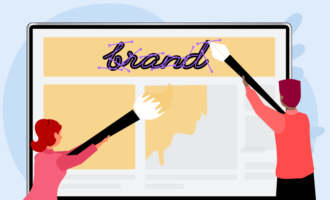Almost everyone is aware of what a brand is. When someone mentions Disney, often the first thing that comes to mind is Mickey Mouse or the castle logo that appears at the beginning of every Disney film. The Disney brand also evokes thoughts of childhood and amusement parks. When thinking of Audi, you may conjure the image of the multi-ring logo and think of social status, perhaps before even picturing a car.
Brands are intangible extensions of the companies, goods, and services they represent, conveying their value in the marketplace as well as the emotions they evoke among customers and the general public. All these things are anchored in the brand’s visual identity — the images that usually come to mind whenever you think of a brand.
The elements of brand visual identity
Brands are more than the companies that own them. By that same measure, a brand visual identity consists of more than the company logo — it’s a language that encompasses everything from font choice to packaging design.
Here are the most common elements.
Graphics
Graphic elements include the logo but can also be any art or visuals specific to a particular brand. Graphics can even be as simple as shapes. For example, many iterations of the Coca-Cola logo feature the distinct glass bottle design that differentiated the organization from other soda companies.
Typography
Typography is another way of describing the font choice that goes into logos, taglines, and other words used on branded materials. Typography gives a sense of what a brand is about. For example, the logo for the TV show Gossip Girl shares the font style of many high-end cosmetic and luxury brands, channeling the upscale lifestyle the main characters enjoy.
Imagery
The work and detail that go into developing brand imagery deserve their own book, but it’s all part of a larger brand identity — especially in the world of fashion.
American Apparel famously began featuring non-models in its campaigns and using basic point and click photography, but it also generated controversy with highly sexualized images. Ads for MAC Cosmetics frequently feature bright, clashing colors or high-contrast imagery.
Physical brand assets
Brand visuals also extend to other elements, such as product packaging or store design. For example, LEGO’s distinctive brick shapes and textures separate it from every other building block toy in the world. And Apple is known just as much for the detail that goes into its stores as for the products themselves.
The objective of a brand visual identity
A brand visual identity serves three purposes.
Informing consumers about the nature of a brand
Brands, and the products and services they offer, often target specific types of consumers — especially when it comes to pricing. After enough exposure to different companies, customers can easily predict product or service costs based on the identity communicated by brand logos, store locations, and even storefronts.
The same company manufactures Toyota and Lexus products, but the two brands have distinct identities and appeal to different consumer demographics. Toyota’s brightly lit and spacious showrooms convey the cars’ attainability and economy, while Lexus showrooms are smaller and full of luxurious finishes to reflect a more upscale lifestyle.
Making an emotional impact
Some of the biggest brands in the marketplace succeed by evoking a lifestyle — and they accomplish this by speaking to consumers’ aspirations and striking an emotional cord.
Nike’s “Just Do It” tagline, for example, appeals to its customers’ desire to actively take control of their lives and be more. By sponsoring athletes, the brand also builds the sense of community and camaraderie that humans instinctively crave.
Unifying a business through consistent visuals
In today’s complex digital world, businesses operate in more channels than ever. In addition to brick and mortar stores, businesses must also maintain an online presence on e-commerce sites and multiple social media platforms. Even television commercials and digital video ads express different tones. A brand visual identity helps tie these channels together by creating consistency among all of them.
The way to streamline business and keep your identity: Jotform
From customer intake and data entry to invoicing and approvals, business processes are more complicated than ever. It’s hard to keep up with your task list while maintaining the integrity of your brand identity.
Jotform offers the best solution — a library of more than 10,000 form templates, as well as Tables and approval workflows, to streamline and automate your most time-consuming tasks.
Best of all, each form is fully customizable to perfectly match your brand visual identity. Each template can incorporate your logo, graphics, typography, color palette, and other important elements to create a cohesive brand experience. You don’t have to sacrifice your style to take advantage of the convenience of this solution.







































































Send Comment: